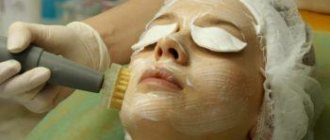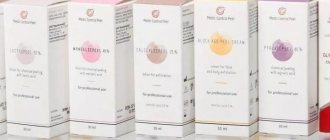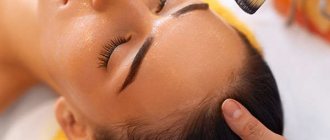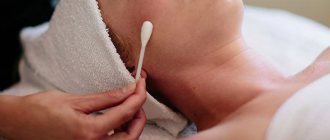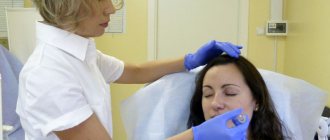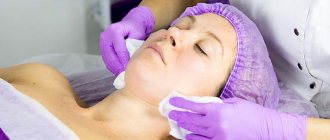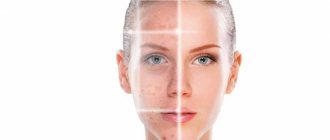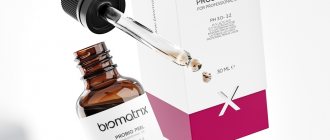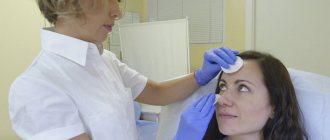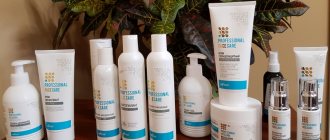Having decided to write an article on the topic “Chemical Peels,” I did not doubt for a second that I would not be doing this alone, because in practice, cosmetologists perform superficial-medium, medium and deep peels, and superficial ones are performed by cosmetology nurses. Therefore, my “right hand”, Alexandra, also took an active part in writing this article.
Everyone knows that since 2009, the profession of “cosmetologist” has officially appeared in Russia, a well-known division into “household” has taken place, and hairdressing salons, which offered “Botox injections,” have become a thing of the past. Nowadays, medical centers providing cosmetology services usually employ cosmetologists and cosmetology nurses. And this is no coincidence. The initial consultation, of course, is carried out by doctors, but then there is a “separation of powers”, all injection procedures are performed by cosmetologists, and procedures without damaging the skin are performed by cosmetology nurses. These include all types of cleansing (including ultrasonic and mechanical), massages, cosmetic treatments, eyebrow and eyelash architecture, various options for hair removal and depilation, as well as superficial chemical peels.
What is a chemical peel?
Chemical peeling is an acid-based product that dissolves dead cells and helps them quickly disappear from the surface of the skin. Depending on the type, concentration and time of exposure, the acid can not only exfoliate the top layer, but also destroy the middle and deep layers of the epidermis. Peels are divided into superficial, medium and deep. And if the first type can be attributed to self-care, then the second and third should be under the supervision of a specialist.
Editor's Choice
Green peeling-biorevitalizant with BTpeel peptides
Innovative two-phase product
A special patented formula makes this peeling painless and can be used at any age. And the effect is noticeable immediately!
Find out the costView composition
It is no secret that the skin, and especially the skin of exposed surfaces (face, neck, décolleté, hands) plays a significant role in shaping the aesthetic appeal of a person’s image. Unfortunately, like other organs, the skin undergoes age-related changes, which can create certain problems and complexes in people; Moreover, the share of the subjective factor in this issue seems to be very high. Involutional changes in the skin are caused by a decrease in the mitotic activity of epidermal and dermal cells, thinning of the Malpighian layer, hyperkeratosis, smoothing of the dermoepidermal border, a decrease in the number of full-fledged type I collagen fibers, elastic fibers, and glycosaminoglycans. Skin aging is characterized by changes in its density, elasticity, ptosis and the formation of wrinkles; in this case, the skin has a covering function, but does not support the rest of the facial tissues. This circumstance seems important from the standpoint of the correct choice of methods for correcting age-related changes in the face, since in addition to the skin, the involution process involves fatty, muscle and bone tissue, and therefore not all costs of age can be corrected by influencing only the skin.
Often, professional and/or personal motives to smooth out the influence of time lead a person to specialists in the field of plastic surgery and aesthetic cosmetology. Currently, to solve this problem, peeling has become widespread as an effective procedure that can eliminate a number of skin defects, as well as promote its “rejuvenation.”
Peeling
(from the English to peel, to peel off - peel off, exfoliate, exfoliate)
is the controlled removal of a certain number of layers of the epidermis and dermis along with existing defects to initiate the restoration of all destroyed layers. Thus, the physiological basis of peeling is stimulation of regeneration.
The doctrine of regeneration is one of the key branches of biology and medicine. Regeneration or revival is the property of organisms to re-form their organs and tissues that have been lost as a result of various reasons. Since the end of the 19th century. There is a division of regeneration into physiological and reparative, however, at present the border between these two types does not seem sharp. Reparative regeneration is based on physiological, the mechanisms for implementing the process are largely identical, and the differences are predominantly quantitative.
A cosmetologist, inflicting damage to the patient’s skin during salon peeling, stimulates reparative processes in it, the degree of manifestation of which depends on the nature and area of the injury. Thus, we can say that the basis of the corrective and “rejuvenating” effects of peeling is reparative (regenerative) morphogenesis.
The healing process can be considered as a complex sequence of interactions between cells, mediators, and components of the intercellular matrix, in the implementation of which a significant role (integration and operational communication) belongs to signaling protein molecules—cytokines.
Indications for peeling include seborrhea, acne and post-acne skin changes, scars, hyperpigmentation, actinic dermatitis, keratosis, hyperkeratosis, age-related skin changes (wrinkles, small folds, decreased turgor), etc. From the perspective of the doctrine of regeneration in elderly and senile people , which is characterized by thinning and atrophy of the skin, it does not seem advisable to prescribe peeling.
Based on the method of exposure, the following main types of peeling are distinguished:
- Mechanical
- superficial, medium (microdermabrasion) and deep (standard dermabrasion). This group includes gommage (peeling without abrasive particles by applying a special mixture to the skin, gluing it to the surface layer of the epidermis, followed by “rolling off” dead horny scales from the facial skin - similar to the action of a pencil eraser), peeling scrub (using abrasive particles) , brossage (hardware or brush peeling). - Chemical
- superficial (fruit acids), middle (salicylic and trichloroacetic acids), deep (phenol). - Physical
- superficial (ultrasound, erbium laser), medium (erbium laser with a penetration depth of 30 microns), deep (carbon dioxide laser with a penetration depth of 80-150 microns).
It should be noted that any type of deep peeling is an aggressive procedure for the skin.
The earliest mentions of manipulations similar to chemical peeling are found in ancient Egyptian papyri dating back to 1.5 thousand years BC. e. Since time immemorial, women have practiced exfoliating the top layers of skin to get rid of aesthetic imperfections on the face. Thus, Turkish women singed their skin with fire, Indian women used urine, Egyptian women used milk sourdough, ancient Roman courtesans, and later French women used grape must.
In the second half of the 19th century. German dermatologist Unna developed a dermatological chemical peeling method using resorcinol, salicylic and trichloroacetic acids for the treatment of certain skin diseases.
At the beginning of the 20th century. French surgeon La Gasse proposed phenol peeling, which was first used to correct gunpowder burns during the First World War. The surgeon's daughter took her father's secret recipes to California, where she introduced peeling into fashion in beauty salons in California and Florida.
In 1903, MasKee's work on the use of phenol solution for peeling was published, and in 1905, Kromayer unveiled a mechanical method for treating acne scars, keratosis and hyperpigmentation by treating the skin with rotating cutters, i.e., the dermabrasion method.
Van Scott's 1974 discovery of the properties of alpha-hydroxy acids and Kligman's research on the use of vitamin A as a treatment for photoinduced skin aging stimulated the widespread use of chemical peeling methods. Chemical peeling can be one-step and requires repetition, it can be carried out using various forms of cosmetics (cream, gel, solution, mask), and can also differ in the method of achieving the goal (peel exfoliant and peeling serum).
Peeling exfoliant
(using trichloroacetic, salicylic acids) promotes the development of a process traditionally called reparative regeneration. Moreover, depending on the depth of skin damage, a different range of structures is involved in its “rebirth”. Thus, when the surface layers of the epidermis are destroyed, restoration is carried out mainly due to the cambial elements of the skin epithelium located in its basal layer, i.e., on the basis of physiological regeneration of the epidermis, mainly by increasing its rate. At the same time, under the influence of cytokines synthesized by keratinocytes, the dermal elements are also activated, and the synthesis of collagen and glycosaminoglycans is enhanced.
With deep damage to the epidermis, and in some procedures to the dermis (phenol peeling), the main source of epithelial cells becomes the cambial elements of the skin appendages - hair follicles and glands, and processes similar to the healing of skin wounds develop in the dermis. The fibrosis of the dermis that forms during deep peeling as a result of the regenerative process, being essentially a pathological phenomenon, nevertheless contributes to the lifting effect desired and expected from the peeling. No other peeling gives such an effective and lasting result in the fight against deep expression wrinkles; Moreover, the achieved effect can last for 5-10 years after the procedure. Phenol peeling is called the “gold standard” of chemical peels. It is given to the patient once in a lifetime. Depending on how accurately the regenerative capabilities of the patient’s skin were assessed and how competently the procedure itself was carried out, phenol peeling either transforms the face, erasing wrinkles and other defects, or creates serious and long-term aesthetic problems for the patient.
The peeling serum causes loosening and exfoliation of the stratum corneum, but the main effect is achieved by weakening the barrier properties of the epidermis and facilitating the penetration into its deep layers of components that affect physiological regeneration. To do this, use a combination of alpha-hydroxy acids (glycolic, fruit, etc.), beta-hydroxy acids (salicylic acid, which has a keratolytic effect), retinol (vitamin A) and ascorbic acid (vitamin C), i.e. combined peeling ABR family (alpha-beta-retinol). The author of the monograph on the problem of peeling (2008) is N.A. Polonskaya believes that the further development of this branch of dermatocosmetology should not follow the path of increasingly severe and deep trauma to the skin, but in the direction of using the skin’s own resources and the body as a whole, using the most physiological methods of influence, if possible without depleting the reparative potential. In this regard, it is worth mentioning that many substances have the property of modulating, and in the light of the problem under discussion, stimulating the physiological regeneration of keratinocytes, and among retinoids, not only retinol, but also retinoic acids. For 13-cis-retinoic acid (INN - isotretinoin), this property has been proven experimentally using morphometric and quantitative immunomorphological studies using markers of DNA synthesis and proliferation - PCNA and Ki-67.
At the end of the 80s. XX century American dermatologist Obagi has developed a “Comprehensive Care Program”, which includes preparing the skin for a chemical peeling procedure and rehabilitation methods. According to his concept, the peeling procedure should include 3 fundamental phases:
- The preparatory stage (pre-peeling)
is aimed at leveling the epidermis and thinning its stratum corneum in order to more evenly penetrate acids and minimize the risk of post-inflammatory hyperpigmentation; at the same time, the reactive properties of the skin and its tolerance to the substances used in the peeling program are checked; - Peeling
; - Recovery period (post-peeling)
- involves a gentle regime (lack of physical activity, minimum facial expressions, avoidance of excess sweating, sleeping on your back, washing with non-hot water), using a moisturizer and sunscreen, spraying mineral water on the skin surface, applying a rich cream at night, when the skin is restored; Of the retinoids, retinol is most often used, applying it in the evening.
Patient management tactics are determined by the characteristics of the morphogenesis of skin structures at a specific stage of the process. Thus, in the acute phase of inflammation (immediately after the peeling procedure), the use of external agents that prevent transepidermal water loss is justified; later efforts should be aimed at eliminating erythema, swelling, preventing the contamination of the wound surface with pathogenic microflora and accelerating wound healing. These circumstances contribute to an intensive search for new means to obtain optimal results.
Contraindications to peeling are many skin diseases (eczema, psoriasis, allergic dermatoses), herpes infection, intolerance to photoprotective agents, pregnancy, the presence of multiple pigmented nevi on the face, hypertension, epilepsy, cancer, a special psychological type of the patient and others.
IN AND. Samartsev and T.R. Minaev note that most contraindications to peeling are relative. When deciding whether to prescribe phenol peeling, special caution should be exercised in relation to patients suffering from diseases of the cardiovascular system, kidneys and liver, since phenol has a toxic effect on these organs as a result of resorption. When performing phenol peeling, it is necessary to have a catheterized vein and the presence of equipment for cardiac monitoring and resuscitation in the operating room.
It should be emphasized that when deciding whether to prescribe peeling, special attention should be paid to the condition of the skin appendages (hair, sebaceous and sweat glands), since it is through them that the skin is largely restored after damage.
Ideas about the permissible depth of peeling vary in the literature. Numerous classifications allow for the possibility of skin damage during peeling, mainly within the epidermis, sometimes the papillary layer of the dermis, and in exceptional cases (with deep phenol peeling) - partially, the reticular layer of the dermis.
Below is a comparative description of the classifications of peelings, according to foreign and domestic publications, presented in the reports of the Scientific and Practical Conference “The Use of Chemical Peels in Dermatocosmetology”:
- superficial peeling
- performed with alpha-hydroxy acids (AHA), retinoids, alpha and beta complexes, while abroad up to the basement membrane, in Russia - within the stratum corneum; - median
- performed with trichloroacetic acid, Jessner's solution (a mixture of resorcinol, trichloroacetic and lactic acids), salicylic acid, abroad within the papillary layer of the dermis, in Russia - within the epidermis; - deep
- performed with phenol, abroad - to the reticular layer of the dermis, in Russia - to the papillary layer.
It should be borne in mind that when carrying out deep peeling, affecting the dermis, you have to sacrifice the epidermis. Cases where acid (all of the compounds presented above are acids) reaches the hypodermis are regarded as an emergency, since such a situation threatens the formation of rough scars.
ON THE. Polonskaya suggests classifying peelings based on the degree of skin damage:
- 1st degree
- within the stratum corneum; - 2nd degree
- within the epidermis without damage to the basal layer; - 3rd degree
- with partial damage to the basal layer; - 4th degree
- with complete destruction of the basal layer.
The degree of damage to skin structures during salon peeling determines the characteristics and duration of the recovery period.
Currently, there is a noticeable advancement of various aggressive techniques, which dictates the need for constant discussion of the feasibility of certain procedures, including on the pages of professional publications. When deciding on the use of a specific technique, it is necessary, first of all, to be guided by the principle “do no harm.” At the same time, both the patient and the cosmetologist are interested in obtaining a positive result. Particular skill lies in the ability to determine the degree of activity of the influence, which allows you to achieve the desired without significant side effects.
The most common currently are peels performed with AHA (mainly glycolic) and retinoic peels. Without touching on the details of the procedures used, we will name the main mechanisms of dermatotropic effects that develop during their implementation and lead to the expected result.
Glycolic acid has a high degree of penetration, its action is based on the destruction of sulfate bonds between corneocytes, disruption of cell adhesion and acceleration of exfoliation, as well as an increase in the number of mitoses in the basal layer of the epidermis. It stimulates collagen synthesis, has an antioxidant, moisturizing effect, reduces the number of melanocytes, and reduces melanin synthesis.
Retinoic peeling
(Yellow Peel) in beauty salons is carried out in the form of applying a mask with 5% retinoic acid. Peeling with retinoids meant a completely new approach to solving the problem of age-related skin changes. These compounds contribute to an increase in the level of mitotic activity of keratinocytes, normalize their differentiation and keratinization, activate the synthesis of the main structures of the dermal matrix (collagen, elastin, glycosaminoglycans), improve re-epithelialization, have a depigmenting and exfoliating effect, have a sebostatic and comedolytic effect, and improve skin texture.
Retinoids for peeling seem to be more promising in their potential than AHAs. By binding to specific cell receptors, they have a direct effect on the epidermis and dermis, while ANAs do not have a direct effect on cells; The clinical effects of ANAs result from indirect activation of keratinocytes in response to increased exfoliation, and stimulation of fibroblasts represents a response to inflammation. At the same time, the author (O.V. Zabnenkova) provides a comparative description of the clinical effectiveness of ANA and retinoids - tretinoin, isotretinoin (which is assessed as equal to tretinoin in therapeutic terms, but with a less irritating effect) and retinol palmitate, and notes that, despite the obvious advantage of retinoids, ANAs continue to occupy a leading position in superficial chemical peeling due to good clinical effect and the absence of systemic complications. The question of what to give preference to in specific cases must be decided individually. Thus, the clinical effects of the use of retinoids are delayed compared to ANA, but persist for 4 months after cessation of use, while with peelings using ANA, the clinical effect is noticeable after each procedure, but pathological keratinization reappears after 3 weeks. In case of photoaging, the use of retinoids, especially tretinoin (all-trans retinoic acid), is pathogenetically more justified, which has been proven at the clinical, histological and molecular levels. The combined use of superficial chemical peeling with glycolic acid with deep stimulation of the dermis by exposing the skin to a cream containing a high concentration (5%) of retinoic acid allows one to achieve optimal results in the correction of cosmetic defects caused by age-related changes.
The main directions of use of retinoids in cosmetology based on their pharmacological action are covered in the article by V.I. Albanova. The author provides justification for the positive effects observed when using these compounds to eliminate conditions caused by impaired sebum secretion, to restore the skin after various damages, to smooth its surface, to rejuvenate and eliminate pigmentation.
Currently, retinoic peels are done using all-trans retinoic acid (INN - tretinoin). Less toxic 13-cis-retinoic acid (INN - isotretinoin) is rarely used for topical use. At the same time, systemic treatment with isotretinoin in the form of the oral drug Roaccutane, which has a number of serious side effects, is combined by some authors with glycolic peeling. At the same time, there are domestic dermatotropic preparations for external use (the only ones today) containing isotretinoin (13-cis-retinoic acid) as an active substance. These are Retinoic ointment (0.05% and 0.1%) and Retasol® (0.025% solution for external use) - pathogenetic agents intended for the treatment of acne.
Currently, to eliminate skin changes caused by acne and seborrhea (follicular hyperkeratosis, enlarged pores, slow exfoliation, uneven pigmentation, uneven skin texture, post-inflammatory spots and scars), regular peeling is a mandatory part of the course of procedures aimed at eliminating these phenomena . Peeling for acne allows you to reduce the dose of systemic retinoidaretinol palmitate. The importance of a comprehensive approach to the treatment of acne and its consequences is also determined by the fact that the long course of this disease reduces the reparative capabilities of the skin.
It is appropriate to note that treatment of acne with external retinoids Retinoic ointment and Retasol® solves several problems at once. This treatment is pathogenetic, as it reduces sebum secretion due to inhibition of terminal differentiation of sebocytes, stimulates proliferative processes in the epidermis (proven, as mentioned above, by experiments using immunomorphological methods), promotes exfoliation of horny scales and prevents the formation of new corneocytes due to inhibition of terminal differentiation of keratinocytes (proven in experiments using an immunomorphological marker of this process - cytokeratin 10), has a whitening effect. Thus, using these drugs, you can simultaneously obtain a peeling effect in the form of smooth, even skin.
Retnoic acid is known to reverse the inhibitory effects of glucocorticoids on wound development and promote the formation of healthy granulation tissue, which has been demonstrated in the treatment of ulcers in patients by topical application of 0.05% tretinoin solution for 4 weeks. Therefore, preliminary treatment of the skin with tretinoin prior to damage to the epidermis (for example, before chemical peeling or dermabrasion) accelerates wound healing. In the pre-peeling procedure, creams with tretinoin concentrations of 0.05% and 0.1% are also used.
Peeling agents are often cauterizing (trichloroacetic acid, phenol). After them, as after using milder exfoliants, skin restoration is necessary. In this regard, most post-peeling care techniques include the use of retinol. I would like to draw the attention of cosmetologists to the fact that in domestic medicine there are preparations containing retinol for external use that have a regenerating effect - Videstim® ointment (contains retinol palmitate), Radevit® ointment (contains vitamins A, D, E), Redecil® ointment (contains retinol palmitate and methyluracil), which have proven themselves in practice.
Thus, the external use of retinoids is currently finding increasing use in dermatology and cosmetology due to their wide range of actions - regulating the function of the sebaceous glands, normalizing the keratinization process, stimulating the renewal of the dermal frame, which makes retinoids an integral part of modern peeling.
Typically, peelings are carried out by professionals - cosmetologists - in institutions specially designed for this. However, in recent years, products for peeling at home have become available on the market. Their relevance is obvious. Many people have skin problems, but not everyone can afford to visit beauty salons, and not all problems are such that they require procedural intervention.
Experts have different opinions about the possibility of peeling at home. Thus, the issue of using products at home that perform superficial mechanical peeling (gommage, scrub) does not raise any controversy or doubt. Chemical peeling, according to a number of experts, can only be carried out in a cosmetology clinic; although other cosmetologists believe that creams containing glycolic or lactic acid in small concentrations can also be used for home peeling. In home cosmetics, the safety of the intervention comes to the fore, in the salon - its effectiveness.
Retinoic peeling has been used relatively recently. Its peculiarity (compared to the most common peeling using fruit acids today) is the renewal of the cellular epidermis due to the direct effect of the substance on the cells, while the renewal of the cellular layer, which occurs after exposure to fruit (primarily glycolic) acids, represents a response to damage. In addition to the modulating effect on the processes of proliferation and differentiation of keratinocytes, retinoids, as noted above, have a keratolytic effect and promote the synthesis of components of the intercellular substance of the connective tissue of the dermis - both fibers and glycosaminoglycans. In the salon peeling procedure, tretinoin is used in concentrations of 5% and 10%. Creams with lower concentrations of tretinoin (0.05% and 0.1%) are used during the pre-peeling procedure. We have not come across any mention of cosmetic products for salon or home peeling containing isotretinoin instead of tretinoin, although the text of this article contains the opinion of O.V. Zabnenkova that isotretinoin is not inferior to tretinoin in biological activity, but has a less irritating effect. Of the other retinoids used in peeling procedures, retinol is mainly mentioned - synthetic or natural (of plant origin). In the “block age” procedure, natural retinol obtained from the urukum plant is the main component of the peeling; in other cases, retinol is part of multi-component creams used in the pre-peeling and post-peeling process.
Some of the drugs and substances developed and produced by JSC Retinoids could also be used in peeling procedures. Thus, for salon peeling, the substance isotretinoin (13-cis-retinoic acid) can be used for the extemporaneous production of a mask. Having a number of products for external use containing retinoids (Retasol®, Retinoic ointment of two concentrations, Videstim®, Radevit®, Redecil®), you can consider the possibility of offering cosmetologists some of them (primarily retinoic ointment) as one of the preparations for pre-peeling, others (for example, Videstima®, Radevita®, Redecila®) - for use in the process of post-peel skin care, Retasol® and retinoic ointment - try to present them as options for peeling products at home. Naturally, these proposals imply working out the relevant indications, methods of implementation and contraindications. It is also possible, apparently, to create a line of drugs that complement each other.
The issue of fighting wrinkles concerns women of all ages. Not all of them visit beauty salons for this purpose. Often, women themselves look for products in stores, consult with specialists and with each other, in particular, on forums on the Internet. It is noteworthy that many are trying to find products containing retinoids for these purposes, for which they try to use 0, 05% and 0.1% Retinoic ointment sold in pharmacies and note a positive effect even after a short use. In this regard, it is advisable to test the possibilities of using these and other topical preparations containing retinoids to solve age-related skin problems, developing appropriate recommendations.
So, the effects of peeling are inextricably linked with regenerative morphogenesis, regardless of whether they are the result of the initiation of the reparative process, a consequence of the activation of physiological regeneration, or a combination of both. When purposefully interfering with the processes occurring in the skin, it should be remembered that by doing so we cause a tension reaction in it, reduce the adaptation reserve inherent in the skin, and risk complications (wound infection, delayed healing, hypertrophic scarring, persistent erythema, pigment disorders, atrophy of the epidermis, telangiectasia, mental disorders, etc.). And finally, the positive result achieved is not permanent. Peeling, as a rule, requires repetition, and each subsequent procedure increasingly depletes the cambial reserves of the skin. Therefore, in each individual case, issues of possible risks and benefits must be carefully weighed.
Conclusion
Peeling is a modern means for improving the appearance of human skin on exposed surfaces, including achieving a “rejuvenating” effect. Peeling is based on regenerative morphogenesis caused by trauma inflicted by a cosmetologist and/or exposure to substances that stimulate regenerative processes in the skin. The pharmacological properties of retinoids allow us to consider them as promising drugs for use in salon and home peeling procedures.
T.A.
Belousova, V.I. Albanova, V.I. Nozdrin JSC "Retinoids", Moscow Print
Can it be done at home?
Superficial peeling can be called “SPA at home”:
- buy the treasured bottle;
- cleanse your face and apply acid to your forehead, chin, cheeks and nose;
- wait as long as indicated in the instructions;
- wash off the peeling;
- apply moisturizer.
It’s more difficult with other peels. You cannot carry out medium and deep peeling yourself for two reasons. Firstly, the acid can “eat in” very deeply; the process must be controlled by a specialist. Secondly, only a cosmetologist always makes a conclusion about the benefits of the procedure for your skin. Otherwise, a chemical burn will simply occur, which can take years to heal.
What skin problem bothers you?
Acne Find out the cost
Skin aging Find out the cost
Problem skin Find out the cost
*In February there is a 60% discount on all BTPeel products.
Types of hardware peeling
Ultrasonic peeling
Dead cells are removed using ultrasound radiation. Ultrasound also “pushes out” skin impurities, which has a beneficial effect on the appearance and condition of the skin. Its advantage is that it is gentle, which makes the procedure possible for those with sensitive, thin, rash-prone skin.
The ultrasound procedure is often supplemented with mechanical cleaning to remove deep contaminants that ultrasound cannot deal with.
Ultrasound cleaning is a mandatory procedure for teenagers during the period of hormonal changes. The skin is not injured, and imperfections become significantly smaller. With regular visits to ultrasound cleaning, the rashes become less pronounced and intense.
Hydro peeling Hydra Facial
The Hydra Fashl device allows you to remove old cells, remove impurities from the pores, and saturate the skin with useful substances. The comprehensive Hydra Facial procedure is suitable as preparation for an important event. Moreover, if you do it in the morning, you will look great in the evening. No bruises, wounds, redness.
After the session, the face acquires a beautiful and even color. Many patients come to Hydra Fashion before corporate parties, anniversaries and other events where they need to look well-groomed.
Laser peeling
Laser skin cleansing and rejuvenation involves the targeted destruction of old cells with a laser beam, which activates collagen synthesis and the appearance of new structural elements of the skin. This type of peeling is actively used for scars (including post-acne), wrinkles, and uneven terrain. Typically, laser peeling is not performed on teenagers. For older patients, such peeling is an opportunity to maintain youth, eliminate deficiencies or consolidate the results of plastic surgery.
We use two lasers - Palomar (Palomar), DOT (DOT). In the first case, the peeling is more intense, in the second - deeper. Therefore, the skin recovery period after DOT is longer.
The laser method is the most effective in the fight against skin imperfections. It can be combined with other cosmetic techniques to achieve lasting results.
How much does a chemical peel cost at a salon?
The cost depends on the type of peeling, the concentration of acids and additional services for the procedure. For example, superficial peeling will cost 2-3 thousand rubles. For the middle one you will have to pay more, on average 5-8 thousand rubles. The price includes not only the drug itself, but also the specialist’s time, makeup removal, and post-procedure care.
CAN CHEMICAL PEELING BE COMBINED WITH OTHER PEELINGS?
It's no secret that any chemical peel is a serious irritant for the skin. And if you don’t know the subtleties, you can harm yourself. Therefore, many women are wary of such procedures.
But, for example, ferulo-almond peeling 16% BTpeel is often used as a base before such procedures as: laser and diamond facial resurfacing, combined facial cleansing and mechanical peeling.
When performed independently, ferulo-almond peeling returns the skin the ability to breathe freely, cleansing it and controlling the functioning of the sebaceous glands, stimulates cell renewal and, as a bonus, eliminates freckles and unwanted pigmentation.
Find out the price
Age dependence
Chemical peeling of the face, after assessing the pros and cons of the procedure, can be performed at any age, but not earlier than 14 years. At a young age, surface polishing is carried out with low concentration fruit acids. General recommendations for superficial and medium peeling - after 30 years, for the prevention and correction of age-related changes.
After 40 years, physiological processes are not so active, the skin undergoes the first visible changes, so a course of several procedures can significantly change the condition of the epidermis from the inside. From this age onwards, deep phenol peels are recommended.
Since the procedure may have contraindications and serious side effects, such sessions should be performed under the supervision of a professional cosmetologist.
How does a chemical peel work?
Chemical peeling preparations contain various acids. They are included in formulations for superficial procedures in a weakly concentrated form - up to 20%, for medium renewal - from 20% to 70%.
Popular types of acids for chemical peeling:
- glycolic;
- salicylic;
- dairy;
- trichloroacetic (TCA peel);
- pyruvic;
- retinol (yellow peeling);
- almond.
Mixtures of acids are used for procedures such as BioRePeel or Jessner peel.
The chemical peeling procedure consists of 3 stages. The first is preliminary cleansing of the skin, using milk and tonic. They remove secretions secreted by the sebaceous glands and normalize acidity (pH).
The second stage is the exfoliation itself: the acid is applied in a thin layer to the entire skin of the face and neck except the area around the eyes. This stage lasts from 10 to 15 minutes. Why is there no exact time? Everyone has individual characteristics. As soon as the skin turns red and the tingling begins, the composition needs to be removed. It is impossible to predict this moment in advance.
And the last stage is neutralization. You cannot simply wash the acid off your skin; this can cause a burn. For this purpose, a special solution with a slightly alkaline reaction medium (neutralizer) is used. And only then the remaining acid is washed off the skin with water. Be sure to apply a cream selected according to your skin type.
Factors influencing peel strength
Photo: pexels.com
The strength of the peeling effect is influenced by pH, type of acid, its concentration and form (gel, cream or other). The lower the PH and higher the concentration, the stronger the peeling will be. Acids also differ from each other in concentration and type of action. For example, salicylic acid is very strong, while mandelic acid is gentle and gentle and is suitable even for sensitive skin. The thickness of the peeling is directly related to the softness of the effect. The thicker the peeling, the softer the effect, and vice versa. Cream and gel are the most gentle forms of peeling.
To minimize the risk of burns and nourish the skin, a neutralizer is usually used. It contains alkali, which will soften inflamed skin and promote its restoration.
How to take care of yourself after peeling
Redness may be observed for a couple of days after the procedure. After this, the skin begins to peel off - do not be afraid of this, on the contrary, the process of cell regeneration has begun. Be sure to apply moisturizer: it removes the feeling of tightness and helps the epidermis recover faster.
For 3 weeks after peeling, cosmetologists do not advise going out in the sun (if you really need it, products with SPF-50 can help); You cannot visit the solarium and sauna. A repeat visit to the doctor is recommended. The specialist will examine the skin, make a conclusion about the tolerability of a particular acid and advise the optimal time for the procedure next time.
How it works
Photo: pexels.com
The desired effect is obtained by burning the upper layers of the epidermis. In response to the burn, the mechanism of regeneration and restoration of the skin is launched, due to which cosmetic problems are solved, and the skin begins to look healthier and more radiant.
Results of exposure to acids:
— The density of the dermis is reduced and wrinkles are smoothed out
— The bridges between cells dissolve and the skin exfoliates
— Pigment spots become lighter and easier to remove
— The appearance of the skin is transformed, it becomes younger and smoother, silkier to the touch
— The process of cellular restoration starts and the skin is renewed
— The skin is filled with water and moisturized
— The functioning of the sebaceous glands is improved, pores are cleaned, blackheads and inflammation go away
— Guaranteed antioxidant protection
Reviews from experts
Figlovsky Konstantin Petrovich, cosmetologist:
Peelings have a very rich history of use in cosmetology and can rightfully be considered one of the most ancient beauty procedures. Nowadays, chemical peels are not losing ground and remain popular, in demand and loved by both specialists and patients, due to their high efficiency and wide range of indications. With their help, we eliminate hyperpigmentation, even out skin tone, correct wrinkles, scars, treat acne and post-acne, acting with acids on different levels and layers of the skin. However, there are still contraindications, the main ones being pregnancy and lactation, skin damage and infections, the presence of an acute inflammatory process, and some systemic diseases.
This is interesting
The best facial scrubs: what to look for when choosing
Kristina Tulaeva, dermatologist, cosmetologist:
Chemical acid peels are an indispensable procedure in cosmetology. Acids gently exfoliate and stimulate the division and renewal of cells in the stratum corneum. The procedure is seasonal, the optimal time to perform it is autumn and winter. Peels differ in depth of penetration and acid composition. Thus, for thin, finely wrinkled skin, superficial peels are perfect; for skin with post-acne scars, medium peels are used. For gentle rejuvenation, superficial peels are suitable for everyone, medium peels are only suitable for indications.
WHAT PEELING CAN BE DONE ALL YEAR ROUND?
In the fall, there is a real boom in cosmetology - the time to “save” the skin after a busy summer has come. Are there peelings that can be done not only in the autumn-winter period, but at any time of the year?
Eat. Red peeling-revitalizant with the peptide complex Red peeling BTpeel is an innovative new generation drug with a biostimulating and renewing effect.
The unique peptide complex in the composition saves aging skin, improves its firmness, density and elasticity. Rehabilitation does not occur as quickly as with some other peels, but it is unnoticeable. That is, you won’t have to be bored at home for a week with a scarlet complexion. And one more plus: the drug from BTpeel does not require neutralization.
However, no one has canceled the main rule: moisturize the skin and use sun protection products.
Find out the price
Contraindications to the use of peelings
Despite the fact that light all-season peeling can be performed without restrictions on the time of year, it is important to take into account the state of the body and diseases in which intensive effects on the skin are contraindicated.
Absolute contraindications:
- individual intolerance to peeling ingredients;
- violation of the integrity of the skin;
- active infectious process on the skin (herpetic rashes, papillomas, etc.);
- psoriasis;
- atopic dermatitis;
- tendency to form keloid scars;
- severe somatic diseases;
- pregnancy and lactation.
Relative contraindications:
- taking medications that have a photosensitizing effect;
- taking retinoids;
- taking immunosuppressants;
- history of poor wound healing;
- mental disorders.
Yulia Prokopenko, leading technologist-expert
educational
Expert opinion
Acid peels are prohibited for severe rosacea. At the initial stage of rosacea, gentle superficial types of peeling are allowed, in which acids are used in a minimum concentration.
Yulia Prokopenko, leading technologist-expert
educational
Popular questions and answers
Why do you need a chemical peel? How often should it be done?
Peels are prescribed in a course for a more pronounced effect.
On average, the course is 4 procedures with an interval of 7-10 days. The exact course is prescribed by the doctor after consultation. It is always individual. Indications for peelings: • dull complexion • pigmentation • uneven skin texture (for example, post-acne scars) • as an additional therapy for acne • gentle skin rejuvenation
Can chemical peeling be done at home?
There are special peelings for home care. They have a lower concentration of acids; such peels are superficial. An excellent addition to home care - as a preparation for salon peeling, prolonging the cleanliness and freshness of the skin. Use the same course, or the entire autumn-winter period with an interval of 2 weeks.
Peels from ARAVIA Professional: professional approach ↑
ARAVIA Professional chemical peels are designed to correct aesthetic skin imperfections as part of complex procedures in beauty salons. These are strictly professional preparations - they are intended for specialists who can determine the skin's reaction to acid and guarantee the safety of the procedure.
Yulia Prokopenko, leading technologist-expert
educational
Expert opinion
Line of multi-acid peelings MG Peel System
has long established itself among cosmetologists and their patients, and the Renew Biopeel line of biorevitalizing peelings is an absolute novelty..
Yulia Prokopenko, leading technologist-expert
educational
Biorevitalization peelings combine the best of two professional procedures: peeling and biorevitalization. Their main feature is their composition. In addition to acids, they contain low molecular weight hyaluronic acid and a powerful active ingredient with a revitalizing effect.
Hyaluronic acid is a biopolymer that is synthesized in the body. As an essential compound, it is found in joints and connective tissue, skin and tissues of the nervous system. With age, its amount decreases, which leads to loss of elasticity, dull skin color, dryness, and the appearance of wrinkles.
Benefits of low molecular weight hyaluronic acid:
- deeper penetration into the layers of the skin;
- powerful moisturizing effect on all layers of the skin, including the reticular dermis;
- stimulates fibroblasts to produce their own glycosaminoglycans;
- binds H2O in the intercellular space, significantly increasing tissue elasticity;
- retains moisture in the epidermis, due to which signs of fatigue, wrinkles and crow's feet disappear.
Peeling-biorevitalizant for oily and problem skin ANTI-ACNE RENEW BIOPEEL
Professional peeling of a new generation with a biorevitalization effect based on a complex of AHA acids (tartaric, glycolic, lactic, malic, almond, citric) and hyaluronic acid. Designed to meet the needs of oily and problematic skin, prone to acne, comedones and enlarged pores, dull complexion, and post-acne elements.
Features: pH 1.5. Acid concentration - 40%.
Indications:
- acne;
- seborrhea;
- post-acne;
- seborrheic keratosis;
- violation of skin microrelief;
- hyperpigmentation;
- enlarged pores.
Effect:
- deep cleansing;
- color alignment;
- reduction of hyperkeratosis;
- sebostatic effect;
- acceleration of resolution of inflammatory elements;
- getting rid of acne marks;
- prolonged hydration.
Peeling-biorevitalizant for mature skin LIFTING RENEW BIOPEEL
Professional peeling of a new generation with a biorevitalizing effect based on lactic acid, hyaluronic acid and DMAE (dimethylaminoethanol). Designed for aging mature skin with visible signs of aging, decreased tone, sagging, dull color, age-related pigmentation and fine wrinkles.
DMAE (dimethylaminoethanol) is an analogue of choline, a B vitamin, a precursor of acetylcholine. It is found in a natural form in the human body. With age, the volume of DMAE in the body decreases, and it becomes necessary to supply it from outside. DMAE promotes the production of acetylcholine, which tightens sagging muscles and skin. Improves blood circulation, helping to fight wrinkles, dryness and swelling from the inside. Protects cells from aging and free radicals.
Features: pH 2.0. Acid concentration - 40%.
Indications:
- age-related changes;
- deterioration of complexion;
- the presence of age spots and other signs of photoaging;
- loss of skin turgor and elasticity;
- hyperkeratosis;
- gravitational ptosis.
Effect:
- prolonged skin hydration;
- activation of regeneration and rejuvenation processes;
- increased turgor and elasticity;
- reducing the depth of wrinkles;
- visible lifting effect;
- even out complexion.
Indications and contraindications for the procedure
A facial peeling roller will help cope with the following problems:
- peeling;
- a small amount of acne;
- fine wrinkles;
- dull skin color;
- loss of skin elasticity.
You should avoid using the product if you have:
- wounds or other injuries on the face;
- inflammatory processes;
- severe rashes;
- allergic reactions to components.
Due to the presence of chemicals in the product, it is not recommended to use it too often. To maintain the effect, several procedures per month will be enough.
Read material on the topic: Glycolic peeling for the face: the pros and cons of the procedure
Effect after hardware facial peeling procedure
- small wrinkles are smoothed out;
- the relief is leveled;
- scars become less noticeable;
- skin looks cleaner;
- the color becomes even and healthy;
- you look rested.
Additionally, to achieve an optimal transformative and rejuvenating effect, use the services of injection cosmetology. Do plasma lifting, attend a mesotherapy session, get Botox injections to correct facial wrinkles. Our cosmetologists will be happy to create a personal set of procedures for you.

